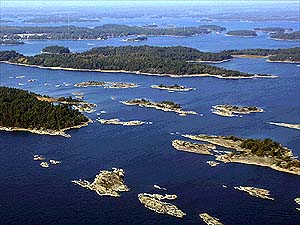Difference between revisions of "Baltic Sea"
From Coastal Wiki
(ref) |
|||
| Line 1: | Line 1: | ||
==Local environment == | ==Local environment == | ||
| − | [[Image:Baltic1.jpg|thumb|left]] The Baltic Sea is one of the largest brackish | + | [[Image:Baltic1.jpg|thumb|left]] The Baltic Sea – a shallow, epicontinental sea of volume as 21,700 km<sup>3</sup> , with a drainage area of ~1.7 million km<sup>2</sup> (http://maps.grida.no/baltic/) - is one of the largest brackish seas in the world. It is situated between 10<sup>0</sup> E ~54<sup>o</sup>N and ~31<sup>0</sup>E to 66<sup>0</sup>N (close to Arctic Circle) being under influence of mild Atlantic climate in south-west end to harsh continental – boreal climate in Bothnian Bay area. It is connected with Atlantic Ocean through system of very narrow and shallow straits (Great Baelt, Øresund and Little Baelt). Drainage runoff (660 km<sup>3</sup> per year) exceeds ten times precipitation (if exclude evaporation) and is 2% of sea volume. |
| − | + | {| border="1" cellspacing="0" align="center", width="500px" | |
| + | |+ '''Table 1.''' Basic data of the Baltic Sea not included in the text (after Bonsdorff<ref name = Bonsdorff > Bonsdorff, E., C. Ronnberg & K. Arnio, 2002, Some ecological properties in relation to eutrophication in the Baltic Sea. ''Hydrobiologia'' 475/476, pp 371-377</ref>). | ||
| + | ! style="background:#efefef;" | Parameter | ||
| + | ! style="background:#ffdead;" | Measure | ||
| + | |- | ||
| + | | Area | ||
| + | | 415 000km<sup>2</sup> | ||
| + | |- | ||
| + | | Length | ||
| + | | 1300 km | ||
| + | |- | ||
| + | | Width | ||
| + | | 1200km | ||
| + | |- | ||
| + | | Maximum depth | ||
| + | | 459m | ||
| + | |- | ||
| + | | Sill depth | ||
| + | | 17m | ||
| + | |- | ||
| + | | Residence time of water | ||
| + | | 25yr | ||
| + | |- | ||
| + | |} | ||
Revision as of 20:39, 23 April 2009
Local environment
The Baltic Sea – a shallow, epicontinental sea of volume as 21,700 km3 , with a drainage area of ~1.7 million km2 (http://maps.grida.no/baltic/) - is one of the largest brackish seas in the world. It is situated between 100 E ~54oN and ~310E to 660N (close to Arctic Circle) being under influence of mild Atlantic climate in south-west end to harsh continental – boreal climate in Bothnian Bay area. It is connected with Atlantic Ocean through system of very narrow and shallow straits (Great Baelt, Øresund and Little Baelt). Drainage runoff (660 km3 per year) exceeds ten times precipitation (if exclude evaporation) and is 2% of sea volume.| Parameter | Measure |
|---|---|
| Area | 415 000km2 |
| Length | 1300 km |
| Width | 1200km |
| Maximum depth | 459m |
| Sill depth | 17m |
| Residence time of water | 25yr |
Specific biodiversity issues
The flora and fauna of the Baltic is unusual in that there are areas in which freshwater, brackish water and marine species co-exist. For example, the freshwater plant Phragmites spp. and the marine wrack Fucus spp. can be found side by side. The Baltic Sea has existed for a relatively short time period and has undergone major changes; subsequently it contains a very limited brackish-water flora and fauna. The area is characterised by low species diversity, but many individuals of each species.
Threats
Many of the marine species present are at the limit of their biogeographical distribution. The highest biodiversity is found in the southwest of the Baltic Sea. The major threats to marine biodiversity in the region are unsustainable exploitation of fisheries resources, eutrophication (enrichment from plant nutrient, reducing oxygen levels), pollution from contaminants and oil and the introduction of alien species.
See also
- Baltic Marine Environment Protection Commission (Helsinki Convention)
- An exercise in comparing the pelagic and benthic macrofauna species diversity in Arctic, Antarctic and Baltic sites using the taxonomic distinctiveness index [1]
- Values of, and threats to, marine and coastal habitats in the southern Baltic [2]
- Shallow sandy sublittoral: the ecological treasure of the southern Baltic Sea [3]
- Daily sea surface temperatures rom the late 1800s to the early 2000s implications for biodiversity in the Baltic Sea [4]
- Application of benthic indices to assess biodiversity in the southern Baltic Sea [5]
Please note that others may also have edited the contents of this article.
|
- ↑ Bonsdorff, E., C. Ronnberg & K. Arnio, 2002, Some ecological properties in relation to eutrophication in the Baltic Sea. Hydrobiologia 475/476, pp 371-377

